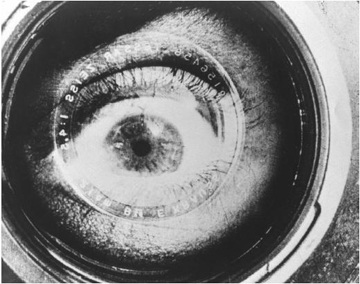I lightly touched on my interest in “posthumanism” and cyborg theory on my last post on John Gerrard. I was a little hesitant to write more about it because a topic like that quickly devolves into people getting cheesy images in their heads of Universal Soldier or The Jetsons. While my artwork is heavily informed by these ideas, making that aspect evident is the last thing I try to do. It’s too easy, too uninteresting. Since Donna Haraway published A Cyborg Manifesto: Science, Technology, and Socialist-Feminism in the Late Twentieth Century, there has been a lot of spilled ink on the matter, making Haraway’s Ur-text seem quaint if it isn’t understood historically. However, it still stands as one of the best introductions to a field it pioneered.
Coming from a background in film theory and history, I put Dziga Vertov‘s Kino-eye squarely in the cyborg realm: “I am an eye. I am a mechanical eye. I, a machine, I am showing you a world, the likes of which only I can see.” Cinema – defined by Gene Youngblood in his 1989 essay “Cinema and the Code” as “the art of organizing a stream of audiovisual events in time”– is for me situated in the realm of the posthuman, a means of accelerating human evolution in a nonbiological way, in a cultural and social way. Video technologies specifically I think, have best represented this shift in human cultural evolution. However, as William Gibson said, “the future is already here – it’s just not evenly distributed.”
In contemporary art, this “future” is also not evenly distributed. Ryan Trecartin is an artist that has created a body of work that avoids being The Jetsons while being completely about “the future.” In I-BE AREA, clones and avatars run around in search of personas and interchangeable identities to embody for a while. Shana Moulton‘s Cynthia in her Whispering Pines series also understands a thing or two about being one with the machine. Jon Rafman‘s Kool-Aid Man In Second Life presents a new recent version the of embodied self, separated from a physical body.





Pingback: The Digest. 03.29.10. « C-MONSTER.net
Pingback: What’s Cookin’ at the Art21 Blog — A Weekly Index | Art21 Blog
Pingback: Future Metaphors: Fractured Time | Art21 Blog
Pingback: Co łączy PUNK i CYBERPRZESTRZEŃ? | OdlotoweAgentki